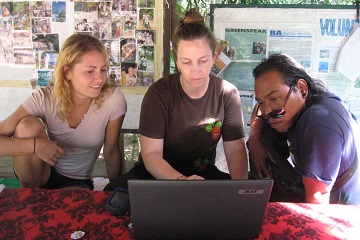SEPTEMBER, 2013 – Mapping roads and villages, and planting seedlings are just some of the tasks Erin Rice, a 36-year-old American, tackled when she volunteered with us on Bali’s Nusa Penida island.

Erin Rice (center) shows French volunteer Angeline Delourme and FNPF’s Kadek Sumertha how to use GPS and mapping software.
Erin, who lives in Perth, Australia, recently took three weeks out from her job as a geographical information systems analyst, to volunteer on the island, a 45-minute boat trip from mainland Bali. We at Friends of the National Parks Foundation (FNPF) have transformed Nusa Penida into a conservation center and bird sanctuary, the only one of its kind in Indonesia in 2006.
An island of history and culture
“I was looking for a place to volunteer in Bali and FNPF had the best website, most informative — and I had always wanted to go to Nusa Penida because that’s where everybody in Bali told me I should never go.” She was told by Balinese people that the island was once inhabited by ghouls, demons and dark spirits, and this supernatural battle of light and dark that gave the island its name.”
Each year dozens of volunteers, from Indonesia and across the world, visit the Nusa Penida sanctuary and get involved in our reforestation and community development programs. Volunteers work in our nursery, our organic garden, plant trees, teach English, art and sustainable farming. Some stay a few days, while others stay for weeks and sometimes even months.
“I have taken a GPS that staff thought was broken … I got it to work and mapped many of the roads and villages in the north-east of the island,” said Erin.
The data will be used by a group of FNPF volunteers, students from France, who are working on a project that includes mapping important aspects of the island, she said.. “I will also take the data back to my office, use my software and hopefully produce a more professional-styled map.”
Barely touched by tourism
Nusa Penida, a tiny island with a hilly interior, surrounded by coral reefs, has so far been barely touched by tourism. It is home to around 45,000 people, though far fewer live permanently on the island.
Everywhere you look on Nusa Penida, like all of Bali, women stroll along with baskets and boxes — full of offerings to the Gods of Balinese Hinduism — balanced steadily on their heads. And every now and then you hear the faint tweets and chirps from some of the more than 100 Bali starlings — one of world’s most endangered birds — that live freely on the island.
This unique sanctuary takes in the neighbouring islands of Nusa Lembongan and Nusa Ceningan, and the 41 villages across all three islands have introduced traditional regulations agreeing to protect the birds. Indonesia has the world’s second-highest number of endangered birds.
Along with geographical mapping, Erin helped plant seedlings, one of the main responsibilities of FNPF’s volunteers, to re-establish the island’s forest cover. The seedlings will eventually feed and shelter the birds after release so they can survive and breed.
Protecting Bali’s biodiversity
She also attended English classes that FNPF runs for school students on Nusa Penida, which she said was a rare and wonderful experience. Rubbish pickup is another job the volunteers take on. The excessive garbage polluting the coastlines of Bali is an increasing problem that many NGOs, such as FNPF, are trying to address.
“I work with a lot of environmental scientists and ecologists and consider myself environmentally aware and I think it’s great to help retain biodiversity in Bali,” said Erin.
She said she loved volunteering on Nusa Penida. “I enjoyed talking to the people the most; it can be frustrating, it can be fascinating and it can also just be a lot of laughter and fun.”
FNPF receives no government funding and relies on the support of volunteers and donors to carry out its work. You can find out more about volunteering on our website or by emailing us at info@fnpf.org.







